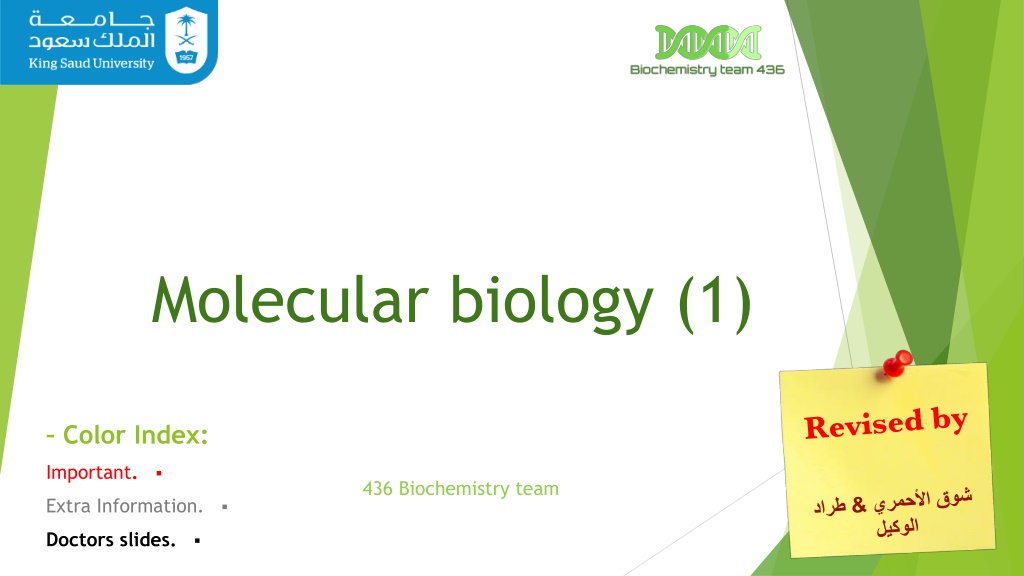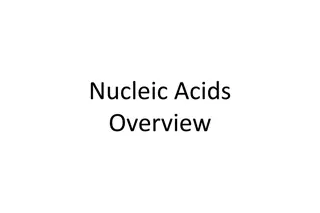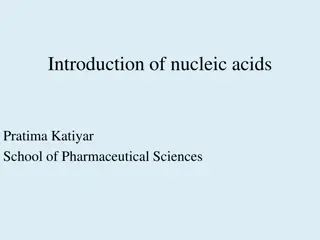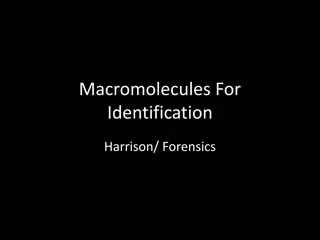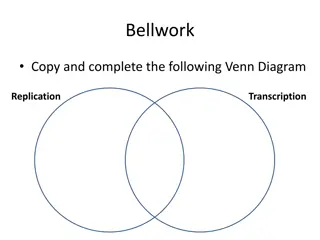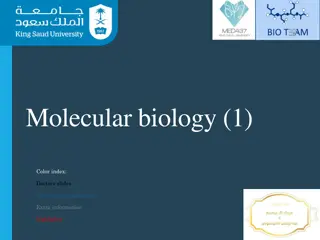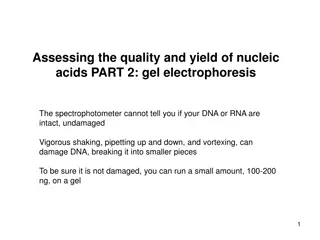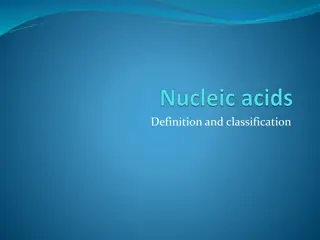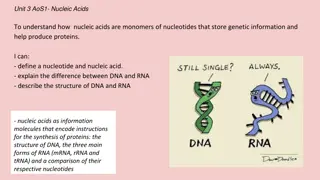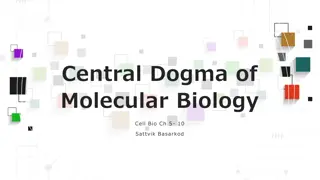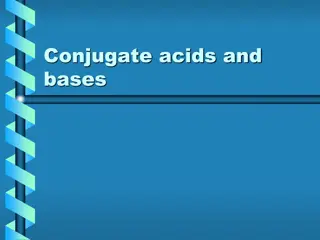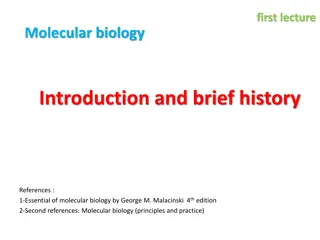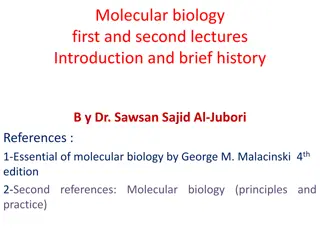Understanding Nucleic Acids and the Central Dogma of Molecular Biology
In molecular biology, understanding nucleic acids like DNA and RNA is crucial for comprehending the central dogma, which explains the flow of genetic information from DNA to RNA to proteins. Nucleic acids are polymers of nucleotides, composed of pentose sugar, nitrogenous bases, and phosphate groups. The structure and composition of DNA and RNA, along with the role of histone proteins in chromosome organization, are key components of this field. Explore the building blocks of nucleic acids, the significance of purines and pyrimidines, and the intricate relationships between nucleosides, nucleotides, and nucleic acids.
Download Presentation

Please find below an Image/Link to download the presentation.
The content on the website is provided AS IS for your information and personal use only. It may not be sold, licensed, or shared on other websites without obtaining consent from the author. Download presentation by click this link. If you encounter any issues during the download, it is possible that the publisher has removed the file from their server.
E N D
Presentation Transcript
Molecular biology (1) Color Index: Important. 436 Biochemistry team Extra Information. Doctors slides.
Objectives: Know the central dogma of molecular biology. Understand the composition, types and structure of DNA and RNA. Describe the organization of DNA in the chromosome and the role of histone proteins. 436 Biochemistry team
The central dogma of Molecular Biology What is The Central dogma ? The flow of information from DNA to RNA to Protein. A portion of DNA, called a gene, is transcribed into RNA. RNA is translated into proteins. Gene: portion of DNA that transcribed into RNA. Human genome contains about 35,000 genes Which counts for 5% of total DNA 436 Biochemistry team
Nucleic acids DNA (Deoxyribonucleic acid). RNA (Ribonucleic acid). Nucleic acid (DNA and RNA) = Polymers of nucleotides (Adenylic acid, Guanlyc Acid, etc) required for the storage and expression of genetic information . Nucleotides = Nucleoside (adenosine, Guanosine, etc) + phosphate Nucleoside = nitrogenous base (Adenine, Guanine, etc) + ribose (sugar ) So.. many nucleoside with phosphate added to it gives us nucleic acid the Building blocks of nucleic acids are nuclueoside triphosphates (nucleotides).
Nucleotides Are composed of: pentose: (Sugar with 5 carbon ring): Nitrogenous base: Phosphate groups Pyrimidines: Purines: Ribose (with OH at C2). Deoxyribose (with only H at C2) Cytosine (C), Thymine (T) and Uracil (U). Adenine (A) and Guanine (G)
- The sugar carbon numbers are primed (1 2 3 etc.), while the nitrogenous base atoms are unprimed. - The nitrogenous base is bonded to C1 of sugar. - The PO4 group is bonded to C3 or C5 of sugar.
NOTICE: Purines: 2 rings and 4 nitrogen inside the rings *You don t have to memorize the structures Pyrimidines: 1 ring and 2 nitrogen inside the the ring it would be a base and ending in "ine" if an H was in X place if a ribose was in X place it would be a Nucleoside and ending in osine if a ribose phosphate (ribose with a phosphate connected to it) was in place of X it would be a nucleotide and ending in ylic acid AMP,GMP, is just an abbreviation
Chemical structure of DNA and RNA -The PO4 bridges the 3 and 5 positions of ribose sugar. -The PO4 and sugar bonding is the backbone of DNA structure. -The linkage between the nucleotides is called phosphodiester bond Glycosidic bond The linkage between nitrogen bases and ribose sugar is glycosidic linkage. - .(phosphodiester) .. - 1 / 5 . * 3
FUNCTION OF NUCLEOTIDES Polymers of nucleotides (as DNA or RNA) store and transfer genetic information. Free nucleotides and their derivatives perform various metabolic functions not related to genetic information Other nucleotides: FAD, NAD, CoA
THE DOUBLE HELIX DNA The structure of DNA was first determined by James Watson and Francis Crick in 1953. Commonly known as Watson-Crick structure. Features of Watson-Crick DNA structure : 1- Two polynucleotide chains wind around a common axis to form a double helix. 2- The two strands are anti-parallel (run in opposite direction). From 5 ----------3 3- Each strand is a right-handed helix. 4- The nitrogenous bases are in the center of the double helix and the sugar-phosphate chains are on the sides . 3-----------5 5-The surface of the double helix contains 2 grooves: the major and minor grooves. Places for bonding to regulate transcription or replication. 6- complementary base pairing , Each base is hydrogen bonded to a base in the opposite strand to form a base pair (A-T and G-C) Adenine (A) Thymine (T) 7-The helix has 10 base pairs (bp) per turn. Guanine (G) Cytosine (C) In RNA, Thymine is replaced by Uracil (U)
Types of DNA structure B-DNA A-DNA Z-DNA Watson-Crick model Right-handed Elongated Wide Narrow Right-handed Short Deep and narrow Wide Left-handed More elongated Not real groove Narrow Zig-zag pattern (nearly perpendicular to the helical axis) 12 G (C2) ; C (C3) 3 2 Direction Helix length Major groove Minor groove Displaced away from the helical axis Centred over the helical axis Placement of bp 11 10 bp per turn Conformation of C3 C2 deoxyribose 2- Non coding RNA : Notes 1- DNA -
DNA supercoiling The chromosomes of many bacteria and viruses contain circular DNA which is supercoiled. The end of DNA of human is not connected like bacteria It is separated. DNA of human DNA of bacteria
Melting temperature The temperature at which the double-stranded DNA is separated into two single strands. MT of DNA depends on nitrogenous base content (A-T and G-C). A-T G-C Type of hydrogen bond Double bond Triple bond - Less stable so needs -more stable so needs higher MT- lower MT- 63-68 c Separated at 90-95 c When reaches the MT only the hydrogen bonds between nitrogen bases are broken
RNA (Types and function) RNA is a single-stranded polymer of ribonucleotides. Types of RNA : Type of RNA mRNA Function Transcription process (from DNA to mRNA). tRNA Recognition and transferring. It recognizes amino acids codons and transfers the selected amino acids to the growing protein chain. rRNA Site of protein synthesis (factory).
Nucleosomes What are they? Nucleosomes are the individual units of chromatin (particles consisting of DNA and histones connected by thin strands of naked DNA) They consist of a segment of DNA wrapped around a core called histone octamer ( 8 particles of histone protein ) Two particles of each histone ( H2A, H2B, H3 and H4 ) assemble to form the core While the fifth type of histone H1 forms the bond between the core and the DNA. ( H1 binds to 2 complete helical turns of DNA.)
HOW DNA IS ORGANIZED IN A CHROMOSOME? How DNA is organized in a chromosome 1- Each chromosome is a complex of a single linear DNA molecule and protein called chromatin. 4- The human genome contains 3.5 billion base pairs and more than 95% is non-coding or junk DNA. 2- The DNA from single 23 human chromosomes have a length of 1 meter. 3- 50% of chromatin consists of protein called Histones * Note ; positively charged means ( polar basic ) histidine is not included because it is a weak base -
MSQs 1- The linkage between the nucleotides is called : a) Phosphate bond (b) phosphodiester bond (c) ester bond (d) phosphoester bond 1- B 2- how many bp per turn in Z-DNA ? (a) 10 (b) 11 (c) 12 (d) 13 2- C 3- The most common DNA form in the body is : 3- B a) A-DNA (b) B-DNA (c) Z-DNA (d) None 4- c 4- Conformation of deoxyribose in the Z-DNA form : a) C3 (b) C4 (c) G (C2) ; C (C3) (d) None
Boys team members: . . . . . . . - 1 - 2 3 - - - 4 5 6 - - 7 - 8 -Team leaders: -Contact us: . . Biochemistryteam436@gmail.com twitter.com/436biochemteam
